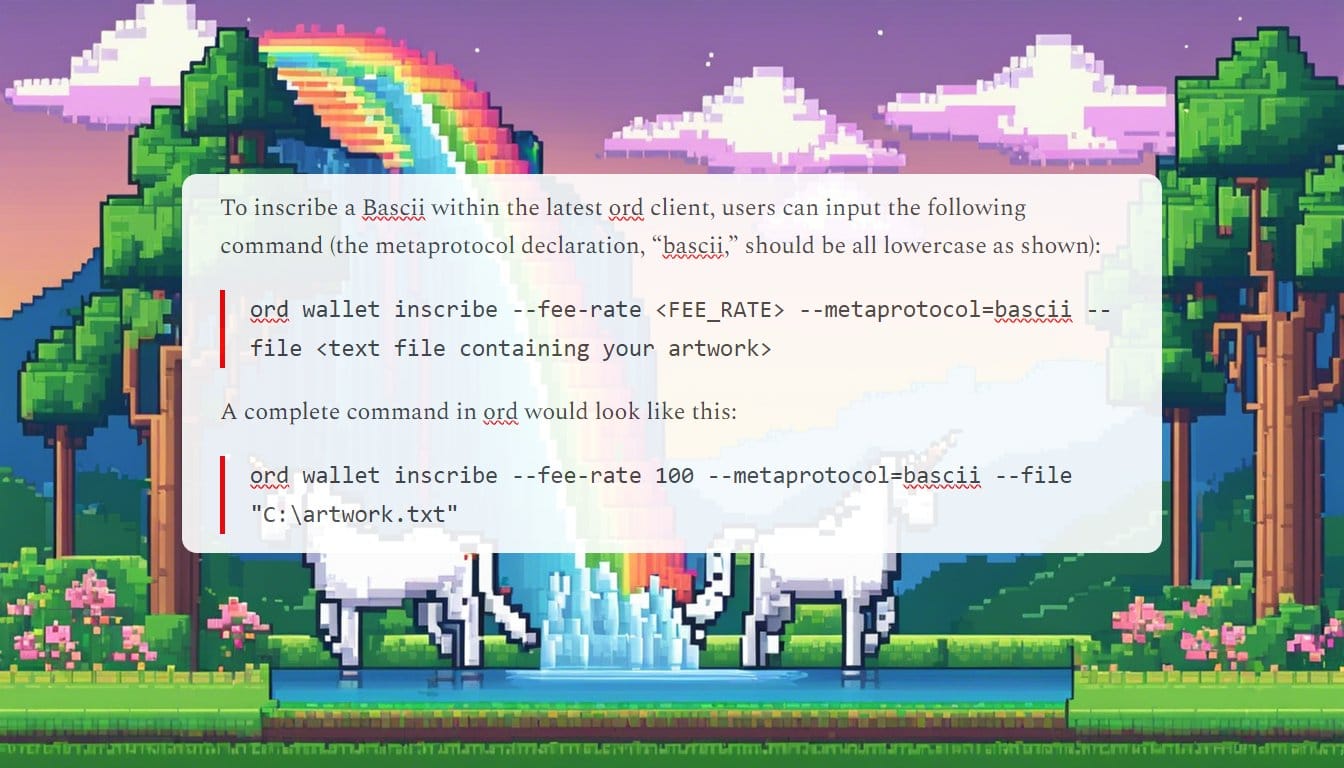Bascii Protocol: A Metaprotocol for Immutable, On-Chain ASCII Art on Bitcoin

The Bascii Protocol is an experimental Bitcoin metaprotocol that combines bitcoin ordinals and ASCII art. It aims to create a standardized method for publishing, swapping, and collecting ASCII artwork on the Bitcoin blockchain.
Basciis are numbered in chronological order and can be used to create art collections and artfully-formatted text on-chain. The protocol takes advantage of the metaprotocol functionality in ord versions 0.10.0+ to declare a Bascii inscription.
The Bascii Protocol offers predictability and standardization, making it easier for third parties to build applications on top of it. If successful, it could inspire the launch of additional metaprotocols on Bitcoin and other chains.
Background
Among the earliest forms of artwork on the Internet, ASCII art uses fonts to create visual or text-based imagery. By standardizing an approach to publishing ASCII art as inscriptions, we can:
- Pay homage to the internet’s earliest cypherpunks and artists
- Create a new subgenre for PFPs, art collections, and artfully-formatted text on-chain
- Take advantage of ASCII’s lower kb size to embed more economical artwork on the bitcoin blockchain
- Collectively agree to set of rules that creates a subgenre of inscriptions dubbed Basciis
- Number all Basciis in chronological order (i.e. the first Bascii is Bascii #0, the second is Bascii #1, etc.) to create a unique subset of inscriptions. Hopefully, this inspires the launch of additional metaprotocol subsets with their own numbering schemes.

Inspiration
Anyone can mint ASCII art on bitcoin right now without needing to follow the conventions outlined above. It raises a question: why bother with a new standard at all?
Several reasons:
- When I first threw the idea for BRC-20 into the world, I thought it was too utopian and naive to work. Domo formalized the idea into a spec, and BRC-20s are now a multi-billion-dollar token category. We can’t know how something will be received until we’ve tested it in the wild.
- I’m fascinated by the fact that creativity tends to expand when you impose restrictions upon it. Many forms of poetry, for example, have rigid rules dictating rhyming schemes and even the number of syllables per line. And yet, much of the world’s most profound literary art comes from the genre. ASCII art is similarly limited to characters on a keyboard. Despite that limitation, ASCII artwork can often be profoundly powerful and moving.
- The Bascii Protocol creates predictability and standardization, which makes it easier for third parties to build interesting applications on top of it.
- Ordinals have the potential to be more than a catch-all basket for any random data type. With the adoption of metaprotocol functionality, ord is morphing into an ecosystem of interoperable standards (see more in the conclusion below).
- It’s a fun experiment (not an investment opportunity!). If it proves successful, it could spark ideas for other interesting metaprotocols on bitcoin. It could also be used in other ways on other chains as well (i.e. doginals, solana inscriptions, twitscriptions, etc.).
Protocol Design
The Bascii protocol takes advantage of a new feature in ord versions 0.10.0+ dubbed metaprotocols. The “metaprotocol convention” uses the following format within ord clients to minimize the size of data payloads:
<metaprotocol>, [op]
This allows us to declare that a given ordinal inscription is a Bascii in the ord client at the moment the inscription is created.
To inscribe a Bascii within the latest ord client, users can input the following command (the metaprotocol declaration, “bascii,” should be all lowercase as shown):
ord wallet inscribe --fee-rate <FEE_RATE> --metaprotocol=bascii --file <text file containing your artwork>
A complete command in ord would look like this:
ord wallet inscribe --fee-rate 100 --metaprotocol=bascii --file "C:\artwork.txt"

By declaring the metaprotocol within the ord inscription envelope, indexers can ignore all other types of inscriptions when indexing Basciis.
Alongside the metaprotocol declaration, all Bascii mints should include a text file that contains the relevant ASCII artwork. Users can optionally include metadata with artwork (such as the piece’s name, description, and traits) by using ord’s built-in metadata functionality. Simply save all relevant metadata in a .json file and reference it with the inscription.
Collections of Bascii artwork can be managed per ord’s parent-child inscription process.
Conclusion
Basciis are a simple experiment designed to create a standard method for publishing, swapping, and collecting ASCII artwork on bitcoin.
It could be used to create lower-cost PFP collections, publish illuminated text, and enable even non-artists to make eternal art (thanks to ubiquitous image-to-ASCII art converters).
The Bascii Protocol creates predictability and standardization, making it easier for third parties to build interesting applications on top of it.
If it proves successful, it could inspire the launch of additional metaprotocols on bitcoin and other chains. It is a fun experiment that explores the limits of creativity and the potential of metaprotocols.




